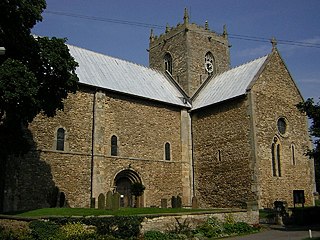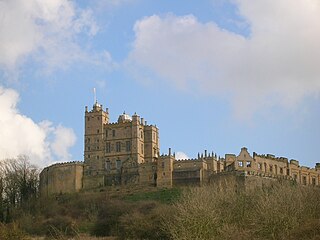There are 588 scheduled monuments in the county of Lincolnshire, England. [1] These protected sites date in some cases from the Neolithic period, and include barrows, artillery forts, ruined abbeys, castles, and Iron Age hill forts. [2] In the United Kingdom, the scheduling of monuments was first initiated to ensure the preservation of "nationally important" archaeological sites and historic buildings. Protection is given to scheduled monuments under the Ancient Monuments and Archaeological Areas Act 1979. [3]

Barton-upon-Humber or Barton is a town and civil parish in North Lincolnshire, England. The population at the 2011 census was 11,066. It is situated on the south bank of the Humber Estuary at the southern end of the Humber Bridge. It is 6 miles (10 km) south-west of Kingston upon Hull and 31 miles (50 km) north north-east of the county town of Lincoln. Other nearby towns include Scunthorpe to the south-west and Grimsby to the south-east.

The Minster Church of St Mary, Stow in Lindsey, is a major Anglo-Saxon church in Lincolnshire and is one of the largest and oldest parish church buildings in England. It has been claimed that the Minster originally served as the cathedral church of the diocese of Lindsey, founded in the 7th century and is sometimes referred to as the "Mother Church of Lincolnshire".

Manton is a village and civil parish in North Lincolnshire, England. The population of the civil parish at the 2011 census was 123. The village is situated just south from the town of Scunthorpe, and about 6 miles (10 km) south-west from the town of Brigg. The parish includes the hamlet of Cleatham. Cleatham was a civil parish between 1866 and 1936.

There are over 670 scheduled monuments in the ceremonial county of Somerset in South West England. The county consists of a non-metropolitan county, administered by Somerset County Council, which is divided into five districts, and two unitary authorities. The districts of Somerset are West Somerset, South Somerset, Taunton Deane, Mendip and Sedgemoor. The two administratively independent unitary authorities, which were established on 1 April 1996 following the breakup of the county of Avon, are North Somerset and Bath and North East Somerset. These unitary authorities include areas that were once part of Somerset before the creation of Avon in 1974.

This is a list of scheduled monuments in the Borough of Erewash in the English county of Derbyshire.

This is a list of scheduled monuments in the district of Bolsover in the English county of Derbyshire.
This is a list of scheduled monuments in the district of High Peak in the English county of Derbyshire.
This is a list of scheduled monuments in the district of South Derbyshire in the English county of Derbyshire.

This is a list of scheduled monuments in the City of Derby unitary authority in the English county of Derbyshire.
There are 134 scheduled monuments in the county of Bedfordshire in the East of England. These protected sites date from the Neolithic period in some cases and include barrows, churches, castle earthworks, moated sites and medieval priories. In the United Kingdom, the scheduling of monuments was first initiated to ensure the preservation of "nationally important" archaeological sites or historic buildings. Protection is given to scheduled monuments under the Ancient Monuments and Archaeological Areas Act 1979.
There are 292 scheduled monuments in County Durham, in North East England. These protected sites date from the Neolithic period in some cases and include barrows, a medieval hospital, ancient Roman sites, castle ruins, Iron Age forts, bridges and Anglo-Saxon crosses. In the United Kingdom, the scheduling of monuments was first initiated to ensure the preservation of "nationally important" archaeological sites or historic buildings. Protection is given to scheduled monuments under the Ancient Monuments and Archaeological Areas Act 1979.
There are 165 scheduled monuments in Bristol, England. These protected sites date from the Neolithic period in some cases and include barrows, a historic shipyard, ancient Roman sites, castle ruins, a Jewish burial structure, bridges, and lighthouses. In the United Kingdom, the scheduling of monuments was first initiated to ensure the preservation of "nationally important" archaeological sites or historic buildings. Protection is given to scheduled monuments under the Ancient Monuments and Archaeological Areas Act 1979.
There are 931 scheduled monuments in the county of East Sussex, England. These protected sites date from the Neolithic period and include barrows, moated sites, ruined abbeys, Iron Age hillforts, and a hill figure. In the United Kingdom, the scheduling of monuments was first initiated to ensure the preservation of "nationally important" archaeological sites or historic buildings. Protection is given to scheduled monuments under the Ancient Monuments and Archaeological Areas Act 1979.
There are 208 scheduled monuments in the county of Leicestershire, England. These protected sites date in some cases from the Neolithic period and include barrows, ruined abbeys, castles, moated sites, churchyard crosses and Iron Age hill forts. In the United Kingdom, the scheduling of monuments was first initiated to ensure the preservation of "nationally important" archaeological sites or historic buildings. Protection is given to scheduled monuments under the Ancient Monuments and Archaeological Areas Act 1979.
There are 689 scheduled monuments in the county of Kent, England. These protected sites date in some cases from the Neolithic period, and include barrows, artillery forts, ruined abbeys, castles, and Iron Age hill forts. In the United Kingdom, the scheduling of monuments was first initiated to ensure the preservation of "nationally important" archaeological sites and historic buildings. Protection is given to scheduled monuments under the Ancient Monuments and Archaeological Areas Act 1979.
There are 1437 scheduled monuments in the county of Northumberland, England. These protected sites date in some cases from the Neolithic period, and include barrows, medieval settlements, ruined abbeys, castles, and Roman forts. In the United Kingdom, the scheduling of monuments was first initiated to ensure the preservation of "nationally important" archaeological sites and historic buildings. Protection is given to scheduled monuments under the Ancient Monuments and Archaeological Areas Act 1979.
There are 402 scheduled monuments in the county of Suffolk, England. These protected sites date in some cases from the Neolithic period, and include stone circles, ruined abbeys, castles, an Anglo-Saxon ship burial windmills. In the United Kingdom, the scheduling of monuments was first initiated to ensure the preservation of "nationally important" archaeological sites and historic buildings. Protection is given to scheduled monuments under the Ancient Monuments and Archaeological Areas Act 1979.